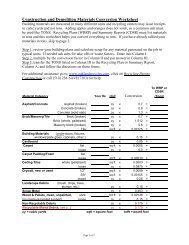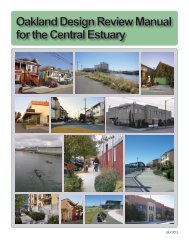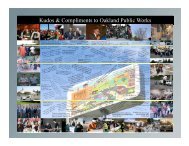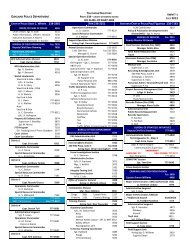Intelligent Transportation Systems - City of Oakland
Intelligent Transportation Systems - City of Oakland
Intelligent Transportation Systems - City of Oakland
You also want an ePaper? Increase the reach of your titles
YUMPU automatically turns print PDFs into web optimized ePapers that Google loves.
Town Center) served by multiple AC Transit lines. The main goal <strong>of</strong> a TOD is to link<br />
transit with high density housing, thus simultaneously encouraging smart land<br />
development and increased transit usage. A TOD <strong>of</strong>fers opportunities for <strong>of</strong>fice space,<br />
retail and other services, community services and housing. A prime example <strong>of</strong> a<br />
successful TOD in <strong>Oakland</strong> is the Fruitvale Transit Village Project, detailed in Section<br />
2.6.9.<br />
As explained for the Activity Centers, this <strong>City</strong>wide ITS Strategic Plan facilitates all<br />
modes <strong>of</strong> transportation. TODs would benefit from the pedestrian and bicycle-friendly<br />
Advanced Traffic Management System (ATMS) technologies recommended in the<br />
deployment plan. Both the technologies and the recommended deployment plans are<br />
detailed later in this report. Furthermore, the process involved in conceptualizing and<br />
designing an effective TOD necessitates close cooperation between different <strong>City</strong> and<br />
transportation agencies, along with the willingness to leverage creative funding<br />
mechanisms. Such interagency cooperation, as well as informed and creative funding<br />
strategies, will also be necessary in the successful deployment <strong>of</strong> citywide ITS in<br />
<strong>Oakland</strong>.<br />
2.2 TRANSPORTATION OPERATIONS, EQUIPMENT AND INFRASTRUCTURE<br />
Section 2.1 provided an overview <strong>of</strong> the citywide transportation system. Currently, the<br />
main ITS components <strong>of</strong> this system are the traffic signals and their controls. This<br />
section will discuss a central signal control system for <strong>Oakland</strong>, the existing signal and<br />
controller inventory throughout <strong>Oakland</strong>, the communications infrastructure and the<br />
<strong>Transportation</strong> Management Center.<br />
2.2.1 Central Signal Control System<br />
Centralized signal control systems allow traffic staff to monitor traffic signal operations<br />
on a computer (or group <strong>of</strong> computers) at a central location, where changes and updates<br />
can be implemented in real-time and from the convenience <strong>of</strong> one location, thus leading<br />
to more effective traffic network operations. The <strong>City</strong> <strong>of</strong> <strong>Oakland</strong> does not currently have<br />
a centralized signal control system. This past year as part <strong>of</strong> the Alameda County<br />
SMART Corridors project, the <strong>City</strong> took a first step towards centralized control by<br />
implementing a BI Tran system with QuicNet s<strong>of</strong>tware along San Pablo Avenue. These<br />
signals along San Pablo Avenue will be controlled from a central computer, and not just<br />
by individual controllers. The limited implementation showcases the effectiveness <strong>of</strong><br />
emerging signal technologies. For example, in conjunction with other ITS technologies<br />
such as Emergency Vehicle Preemption (EVP) and closed-circuit television (CCTV)<br />
cameras, the system could invoke signal priority for emergency vehicles, by triggering<br />
and holding green phases to create an access or evacuation corridor for emergency<br />
vehicles.<br />
Other signal projects in progress or recently completed include the North Central<br />
Business District (CBD) and Hegenberger Road/73 rd Avenue Controller and Signal<br />
Interconnect Upgrade Project and the Broadway Transit Priority Project. Details <strong>of</strong> these<br />
projects are discussed in Section 2.4.1. These projects are not currently connected to a<br />
central control system.<br />
The <strong>City</strong> <strong>of</strong> <strong>Oakland</strong> has approximately 700 traffic signals. Except for the signals on San<br />
Pablo Avenue, these signals operate independently. Any coordination (for example, in<br />
<strong>City</strong> <strong>of</strong> <strong>Oakland</strong> ITS Strategic Plan<br />
8 September, 2003
















